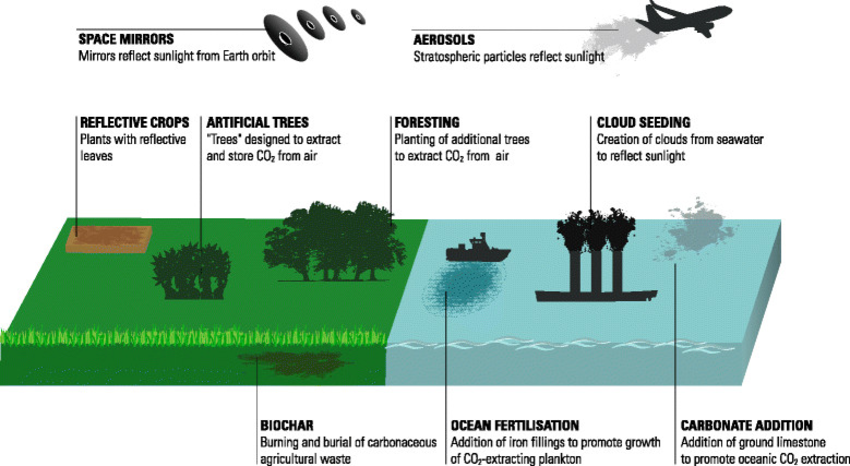Biodiversity & Environment
Stratospheric Aerosol Intervention Impact on Global Food Production
- 12 Oct 2023
- 7 min read
For Prelims: Stratospheric Aerosol Intervention, Geoengineering Technique
For Mains: Application of Geoengineering Techniques and Concerns, Science and Technology- Developments and their Applications and Effects, Climate Change.
Why in News?
A recent study published in the journal Nature Food highlights the potential consequences of a geoengineering technique, stratospheric aerosol intervention (SAI), on global food production.
What are the Key Highlights of the Study?
- SAI as a Climate Intervention:
- SAI is considered a Plan B for addressing climate change if traditional mitigation strategies fail.
- SAI mimics volcanic eruptions by injecting sulphur dioxide into the stratosphere (layer of atmosphere extending from about 10 kilometres to 50 km in altitude), where it oxidises to form sulphuric acid, which then forms reflective aerosol particles.
- For example, Mount Pinatubo in the Philippines erupted in 2001 and injected about 15 million tonnes of sulphur dioxide into the stratosphere, which then formed aerosol particles.
- According to the National Aeronautics and Space Administration(NASA), it caused a drop in the average global temperature of about 0.6 degrees Celsius over the next 15 months.
- Diverse Impact on Agriculture:
- Reduction in temperature due to SAI affects agriculture differently based on factors like precipitation and solar radiation.
- Understanding the ideal global temperatures for crop production is crucial for informed decision-making.
- Researchers employ computer models to evaluate the effects of SAI scenarios on crops like maize, rice, soybean, and spring wheat.
- Under uncontrolled climate change, crop production thrives in cold, high-latitude areas like Canada and Russia.
- Moderate SAI levels could enhance food productivity in mid-latitude temperate regions like North America and Eurasia.
- Under large amounts of climate intervention, agricultural production in the tropics could see an increase.
- These regions include Mexico, Central America, the Caribbean and the top half of South America, most of Africa, parts of the Middle East, most of India, all of Southeast Asia, most of Australia and most of the island nations of Oceania.
- Different nations may opt for varying SAI levels to maximize crop production, considering their geographical location and climate conditions.
- Reduction in temperature due to SAI affects agriculture differently based on factors like precipitation and solar radiation.
- Comprehensive Impact Assessment:
- Beyond crop production, the study underscores the need to explore other consequences, such as effects on human health and ecosystems.
What is Stratospheric Aerosol Intervention (SAI)?
- SAI is a proposed method of solar geoengineering (or solar radiation modification) to reduce global warming.
- This would introduce aerosols into the stratosphere to create a cooling effect via global dimming and increased albedo, which occurs naturally from volcanic winter.
- However, some of the possible disadvantages of SAI are that it could have unintended consequences for the environment and human society, such as affecting the ozone layer, the hydrological cycle, the monsoon systems, and crop yields.
What is Geoengineering Technique?
- About:
- It is a term that refers to the deliberate large-scale intervention in the Earth’s climate system to combat climate change.
- These interventions generally fall into two categories: Carbon Dioxide Removal (CDR) and Solar Radiation Management(SRM).
- Carbon Dioxide Removal (CDR):
- These techniques aim to remove excess carbon dioxide from the atmosphere, thereby reducing the greenhouse effect.
- Examples of CDR Techniques:
- Afforestation and Reforestation:
- Planting trees or restoring forests to increase the natural absorption of carbon dioxide by plants.
- Biochar:
- Converting biomass into charcoal and burying it in the soil to enhance its carbon storage capacity.
- Bioenergy with Carbon Capture and Storage (BECCS):
- Growing crops for biofuel production and capturing the carbon dioxide emitted during combustion and storing it underground or in the ocean.
- Ocean Fertilization:
- Adding nutrients such as iron or nitrogen to the ocean to stimulate the growth of phytoplankton that consume carbon dioxide and transfer it to the deep ocean.
- Afforestation and Reforestation:
- Solar Radiation Management (SRM):
- These techniques aim to reduce the amount of solar energy that reaches the Earth’s surface, thereby cooling the planet.
- Examples of SRM Techniques:
- Stratospheric Aerosol Intervention (SAI).
- Space-Based Reflectors (SBR):
- Placing mirrors or other devices in orbit around the Earth to deflect or block some of the incoming sunlight.
- Marine Cloud Brightening (MCB):
- Spraying sea water droplets or other substances into low-level clouds over the ocean to increase their reflectivity and albedo.
- Cirrus Cloud Thinning (CCT):
- Reducing the formation or persistence of high-level cirrus clouds that trap heat by cloud seeding them with ice crystals or other agents.
- Surface Albedo Modification (SAM):
- Changing the reflectivity of the land or sea surface by painting roofs white, covering deserts with reflective sheets, or increasing the ice cover.
UPSC Civil Services Examination Previous Year Question (PYQ)
Prelims
Q. In the context of which of the following do some scientists suggest the use of cirrus cloud thinning technique and the injection of sulphate aerosol into stratosphere? (2019)
(a) Creating the artificial rains in some regions
(b) Reducing the frequency and intensity of tropical cyclones
(c) Reducing the adverse effects of solar wind on the Earth
(d) Reducing the global warming
Ans: (d)





